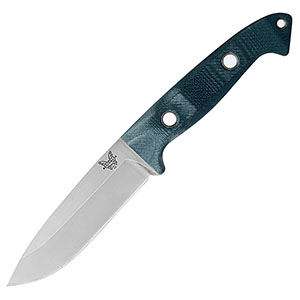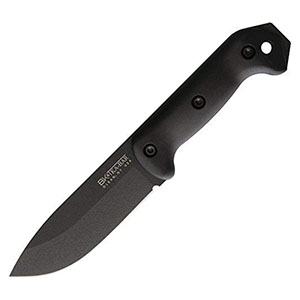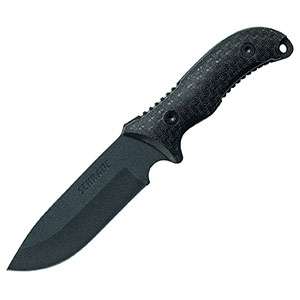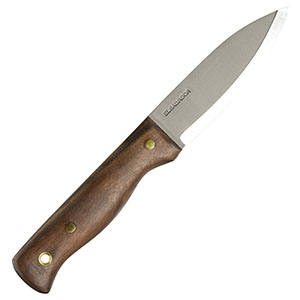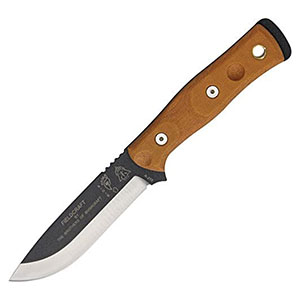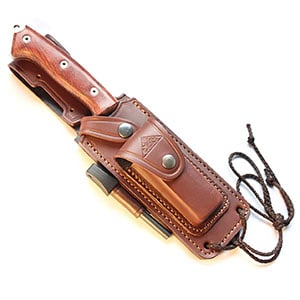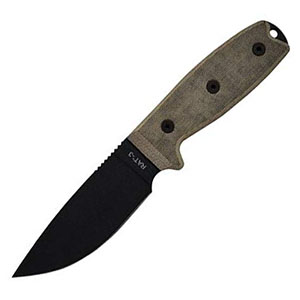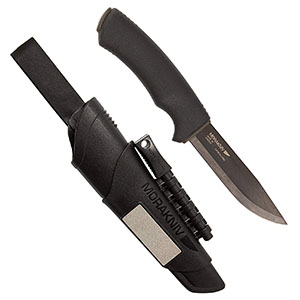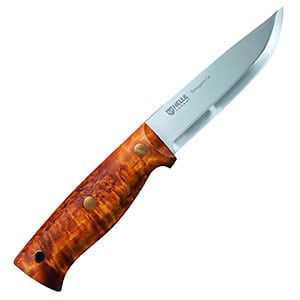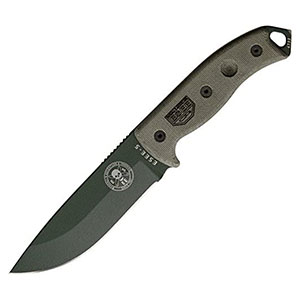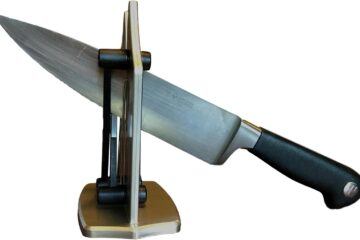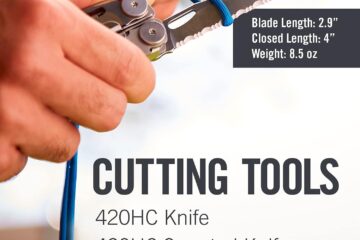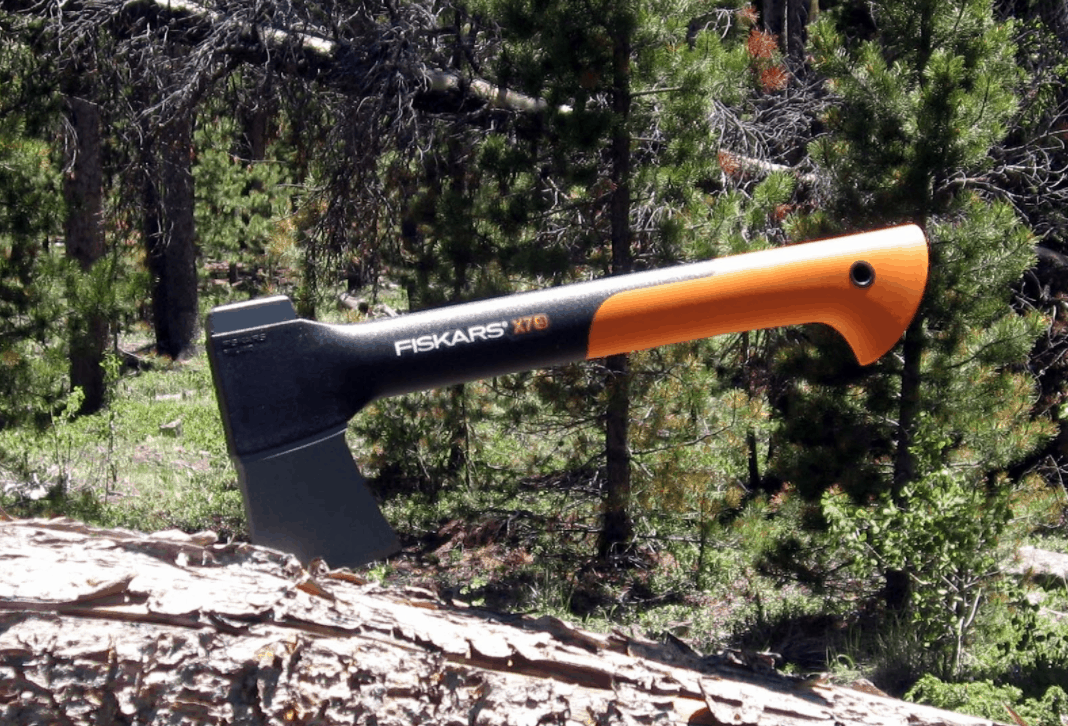The term ‘bushcraft’ is an umbrella term used to describe a set of outdoor survival skills. The term emerged from the Australian Outback decades ago and essentially implies the ability to live off the land using nothing more than what you carry with you. The bushcraft knife emerged from this outdoor survivalist tradition.
Most people who venture into the backcountry today take pretty much everything they need with them. In spite of that they’ll still need a tough, dependable knife to harvest firewood, carve tent stakes and, should the SHTF, enable their survival.
Bushcraft knives are a distinct sub-category of outdoor knives with a decidedly all-purpose air about them. They’ll help you hunt, prepare food, fabricate shelter and even defend yourself. The following are the best bushcraft knife options on the market today.
1. Benchmade Bushcrafter 162
Some folks might think the Benchmade Bushcrafter 162 is too pretty to take into the backcountry. They’d be wrong. Sophisticated good looks aside this is a purpose built bushcraft knife that will whittle tent stakes as easily as it will save your bacon in a pinch.
It features a 4 3/8 inch S30V stainless steel blade that is highly corrosion resistant. That blade is also full tang so you can put some shoulder into your task when need be. When you do, you’ll find the thermoset plastic laminate G10 handle provides a sure, comfortable grip.
2. Ka-Bar Becker BK2 Campanion
The Ka-Bar Becker BK2 Campanion is a thoroughly, unapologetically 21st century bushcraft knife. It features a 4 3/8 inch 1095 high carbon, full tang blade, a nylon handle that’s light and grippy and a hardened plastic sheath with ripstop nylon belt loop.
The lines are clean and modern. The balance is impeccable. And at just over 6 ounces it’s incredibly light for a knife that’s more than 9 inches in length. This is a knife built for the long haul. Unfortunately, the same can’t be said for the sheath.
3. Schrade SCHF36 Frontier
There’s an awful lot to like about the Schrade SCHF36 Frontier. Start with the look of the knife. Which is fantastic. Dark, slightly menacing but beautifully realized from pommel to tip it’s almost a shame you have to put it to work. When you do you’ll appreciate the 1095 high carbon steel, full tang, drop point blade, the outstanding grip and the peerless balance of the thing.
The Frontier is tough as nails and with a nice thick spine will hold up well to batoning. It comes with a slightly concave hollow grind edge that’s very sharp and works well with a ferro rod when you need to spark up a fire. If there’s a weak point it’s the sheath. But it’s not much of a weak point.
4. Condor Bushlore Survival Knife
The Condor Bushlore Survival Knife is a huge favorite among bushcrafters for a lot of very good reasons. Like the Schrade Frontier it’s a great looking knife. The walnut handle is beautifully executed and is going to resonate with traditionalists.
The 4 3/8 inch drop point, full tang, carbon steel blade is all business and the balance is outstanding. When working with it it feels like an extension of your hand. Which is exactly what a knife should feel like. The leather sheath is also simple, handsome and effective. You’ll pay a bit more for this exquisite bushcraft knife. But you’re not likely to regret it for one second.
5. Tops Knives Brothers of Bushcraft
The Brothers of Bushcraft knife from Tops Knives sports a traditional look with a slightly aggressive profile. It has a 1095 high carbon, full tang, drop point blade that’s 4 3/4 inches long and features a Scandi grind out of the box.
Despite appearances the handle is micarta and not wood. And while the die hard traditionalists among us would prefer to see wood, we can’t argue with the quality of the grip. Or how light the knife is, considering the size. The kydex sheath is durable as the day is long and the included fire stick is always nice to see.
6. CDS Survival Celtibero Survival Knife
This is a very handsome knife with a cocobolo wood handle and a 5 3/4 inch stainless steel blade. That blade is full tang and has a lanyard loop/glass breaker at the butt end. Almost as noteworthy as the knife itself is the genuine leather sheath.
It comes with a pocket for your sharpening stone and a ferro rod for starting fires. That sheath attaches easily to your belt and has a restraining strap to keep the knife in place at all times.
7. Ontario Knife Company 8665 Rat-3
The best way to describe the Ontario 8665 Rat 3 would be ‘no nonsense’. It features a very simple design that’s bold and handsome, a 3 1/2 inch full tang, 1095 carbon steel blade and a flat grind. This is not an imposing rock star knife like some of its larger counterparts.
Instead, it’s that rock solid performer who shows up for work every day and never complains. It’s light, sharp, provides a good grip and can be carried discreetly in your pack or in the nylon sheath.
8. Morakniv Bushcraft Carbon Steel Survival Knife
From a visual perspective the Morakniv doesn’t look like much. The profile even seems a bit awkward. But then you hold the knife in your hand and a deep sense of “Ohhh I get it” comes over you. This is a knife designed to be used, and used often.
The knife is beautifully balanced, razor sharp right out of the box and the handle enables a nice firm grip in any conditions. It includes a fire starter kit rated to 7,000 strikes that will work dry or soaking wet. You can really lean into your task with this knife. In spite of the blade being 3/4 tang rather than full tang. That’s about the only thing reason it’s this far down on our list.
9. Helle Knives Traditional Field Knife
If you’ve got a few extra bucks to spend you might want to consider the Helle Knives Traditional Field Knife. Each one of these is hand made in Norway by a company that’s been in business almost 90 years. The stainless steel, full tang blade is 3 1/2 inches long.
The handle is fashioned from birch and has a wonderful feel to it. There’s a minimalist, genuine leather sheath that provides almost full coverage. And at 3 ounces you’ll be able to work with it all day.
10. ESEE Knives 5P Fixed Blade Knife
The last of our best bushcraft knives is this big boy from Esse. The 5P is an impressive 11 inches in length overall with a 5 1/4 inch, full tang, 1095 carbon steel blade. The handle is fashioned from canvas micarta and provides a comfortable, dependable grip. The Kydex sheath, while a bit utilitarian looking, is nonetheless effective and durable. There’s also a glass breaker pommel and a wee bit of jimping on the spine for stability.
FAQs
What Makes a Knife a Bushcraft Knife?
Just as there are myriad types of kitchen knives, there are also myriad types of outdoor knives. The survival knife, the pocket knife, the hunting knife and the bushcraft knife, just to name a few.
The blade on a typical bushcraft knife is less than 6 inches long. Many are in the range of 4 or 5 inches. This length makes it easy to stow away or carry. At the same time, it’s long enough to be useful for any number of tasks, including:
Gathering wood for fires – You’ll likely spend more time doing this with your bushcraft knife than anything else. The bushcraft knife is big and tough enough to reduce larger pieces of wood into smaller pieces you can use to get a fire going.
Batoning – Some pieces of potential firewood will be too large to cut with your bushcraft knife. In that case you’ll want to baton (1) them. This entails using your bushcraft knife as a wedge and striking the spine of the blade with a medium size piece of wood. This drives the knife into the wood, breaking off pieces of usable size.
Building a shelter – If you have become lost and don’t have a tent with you your ability to create a shelter for yourself may make the difference between life and death. A good bushcraft knife will allow you to gather the resources necessary to construct a perfectly adequate shelter.
Starting a fire – Many bushcraft knives come with a firestarter component. These create red hot sparks when you drag the knife over them. This is an invaluable thing to have because it means even if you lose your lighter and your matches are soaking wet you can still get a fire going.
Hunting and preparing food – Should you find yourself in a survival situation a bushcraft knife will enable you to hunt and fish. You can either lash the knife to the end of a branch and use it as a spear (not recommended). Or use the knife to whittle the end of that branch to a lethal point and hunt or fish with that. Once you snag that rabbit or trout you can skin it, slice it and/or fillet it.
Self defense – Let’s not forget that a good bushcraft knife is also a first class self-defense tool. We’re not necessarily talking about fighting off your fellow man. Although it will do a good job of that too. We’re talking about fending off a bear attack (2). Or, perhaps a wolf attack. Believe it or not people have fought off such attacks using only a knife. Sure, they’ll often emerge with some serious wounds, but the important thing is they emerge.
What Should I Look for in a Bushcraft Knife?
There are actually quite a few things to consider in order to ensure you get a high-quality, durable and effective bushcraft knife. Those things include:
The blade material – If your bushcraft knife is going to deliver for you on a consistent basis it’s critical that the blade is fashioned from high-quality steel. Stainless steel and carbon steel are the two best and most common choices.
The handle – You can have the sharpest, most durable blade on planet earth but if your handle doesn’t provide you with a rock solid grip in all conditions it won’t matter. Wooden handles are traditional and provide a very comfortable grip. But there are plenty of folks who prefer a handle fashioned from some synthetic material like micarta (3) that has lots of knurling. Other people swear by the hold you get from a rubber or rubberized handle. But the choice is yours.
Type of blade – When it comes to bushcraft knives we are devotees of the fixed blade. That much should be apparent from our list. However, there are people who prefer a folding blade because it’s easier to carry and lighter than full tang fixed blades. There is also no doubt that a folding knife is more discreet. And if you believe you may encounter a fair number of people where you’re going, discretion may be a wise choice.
The blade grind – The grind of the blade will determine not only how effective it is, but how long it holds up to regular use. Many people believe the Scandi grind to be the best grind for a bushcraft knife (4). Mostly because it’s excellent for working with wood. Still, there are others who swear by flat grinds, convex grinds and the chisel grind. The great thing about your knife though is that you can always change the grind if you’re not happy with what you have.
The price – Bushcraft knives run the pricing gauntlet from very affordable to pretty expensive. While none are likely to break anyone’s bank you still need to ask yourself how much a good bushcraft knife is worth to you. How often are you likely to use it? What will you use it for? Where will you use it? What is the weather like where you’re going to use it? These are all questions to ask before you spend your hard earned money on a knife. The one thing you should never do is buy the cheapest knife on the market just because it’s cheap. That’s asking for trouble.
What Type of Steel is Best For a Bushcraft Blade?
These days most bushcraft knives are fashioned from either high-carbon steel or stainless steel. Stainless steel (5) is the go to choice of metals when you need something that isn’t going to rust out from under you. This characteristic makes it an outstanding choice for any knife you plan to use outdoors. If there’s a downside to stainless steel blades it’s that they are typically softer than high-carbon steel blades. ‘Softer’ is a relative term, however. You’d have to lean into your stainless steel blade pretty hard to break or otherwise damage it.
High-carbon steel (6) on the other hand is rock hard and ready for anything you encounter in the backcountry. As a result, they hold an edge exceedingly well. So you won’t have to be reaching for the sharpening stone every evening. The downside, and you knew there was one, is that they are not as corrosion-resistant as stainless steel. So unless you live in the desert Southwest or the Outback you’ll need to make sure you dry it thoroughly after every use. Also, you shouldn’t leave it exposed to the rain.
Is One Blade Shape Better Than Another?
You want your bushcraft knife to be durable. As such the shape of the blade is important. Something like a clip point blade with its fine, tapered tip just isn’t going to cut it, so to speak. At the same time you want a nice long continuous cutting surface. That of course means that serrated edges are out. Simply because they chew up too much knife-edge real estate. Ideally, you’d want a drop point blade (7) because it allows for a long, uninterrupted cutting surface and it’s durable as all get-out. The tip is also pointy enough to be used for tasks that require some precision.
Is It Necessary to Have a Full Tang Blade?
‘Full tang’ means the blade is crafted from a single piece of steel that extends from the butt of the knife, through the handle all the way to the point. The two halves of the handle are then fastened to the steel running between them. This type of blade is extremely tough, allows you to apply a lot of leverage to your task and can be used even if the handle material breaks. So, perhaps a better question would be “Why would anyone not want a full tang blade on their bushcraft knife?” If you can come up with a compelling answer to that, we’re listening.
Be aware, however, that there are different types of full tang blades. They all extend from end to end, but differ in regards to what happens when they disappear into the handle. Skeletonized tang blades basically just have big sections of steel removed from them. Leaving a kind of steel framework inside the blade. Partial tang blades taper as they move toward the butt end of the knife. While stick tang blades are thinner inside the handle. All of these styles were created as a way for manufacturers to cut costs. While we would always prefer a true full tang blade a skeletonized blade will do in a pinch.
Which Type of Sheath is Best?
Which type of sheath is best is largely a subjective decision. Some will be best for prolonged wet weather. Others will be best if you want to keep moving and are trying to keep everything as light as possible. Still others might be considered best because they’re cheap and reasonably durable. So it comes down to your notion of ‘best. That said, the different sheath materials all have their pros and cons.
Leather – Leather has centuries of history on its side as well as the hard-to-beat look and feel of natural material. It’s incredibly durable too. If you’re a traditionalist at heart you’re going to want leather, if it’s available from the manufacturer. The downside is the price and that there’s some maintenance involved.
Nylon – Nylon sheaths are increasingly common because they’re cheap to make. In their defense they’re also light and some are reasonably durable. On the downside they look cheap and they tend to stretch with repeated use.
Kydex – Kydex (8) is a type of thermoplastic that’s incredibly tough. Because of that it’s often used for gun holsters. For us, the look is an acquired taste. But there’s no denying it’s fully weatherproof and will hold your knife nice and snug for years.
Plastic – There’s Kydex plastic and then there’s regular plastic and the two are not the same thing. Plastic sheaths are typically found on cheap knives and frankly, there isn’t a lot that can be said in their defense. Other than they’re light.
The Bottom Line
A good bushcraft knife is indispensable to the hunter, hiker or general outdoorsman. It ensures that, if push comes to shove, you’ll always be covered regarding the 3 pillars of survival: food, shelter and self defense.
But it’s more than just a lifeline in the event of an existential crisis. It also fulfills multiple roles around the camp, including gathering and preparing wood, whittling tent stakes and starting a fire.
The bushcraft knives on our list have all demonstrated their quality and value. They’re prime examples of the knifemaker’s art and are sure to provide you with many years of dependable service.
